Building Resilience of a Beekeeping Industry after a Volcanic Eruption (La Soufriere, SVG)
A beekeeper’s Perspective
Prepared by Allan Williams – Apicultural Extensionist of the Ministry of Agriculture
24 May, 2021
On New Year’s Eve 2020, while a church was climaxing its end of year celebrations, there was a declaration heard from the preacher of an impending eruption of the La Soufriere volcano located in the island St. Vincent. The preacher had witnessed one week earlier, the early signs of a volcanic eruption when he had gone on a hike to the volcano with some of his friends. That expedition reminded him of familiar signs that he had seen on a similar hike in 1979 when he had also climbed to the summit before the volcanic eruption of that year. The popular and amusing cliché, “me nah go back ah Soufriere,” echoed from his lips – and the congregation chuckled – but his facial expression betrayed the gravity of his thoughts. Before the end of his sermon, he declared a more precise prediction that was seemingly based on his previous experience. He boldly declared that sometime in April 2021, there would be a volcanic eruption. And it was so. The preacher, being one of the persons who ascended to the summit and had made his own verifications, offered special prayer that night on New Year’s Eve for the nation that there may not be any loss of lives, and that the destruction of the volcano, if any, would not be as expansive and devastating as the previous 1902 and 1979 eruptions.

Photo – a spectacular view of the mushroom cloud from the distance. Notice the nature art that traces a man’s face and curly hair beyond the rain clouds. This was one of the early eruptions on the morning of April 9th 2021 taken south of the La Soufriere.
Meanwhile, sometime earlier in December 2020, an alert was given by the authorities that the experts had detected increased seismic activity from the La Soufriere volcano and that it was soon to erupt. The last three eruptions of the La Soufriere volcano on mainland St. Vincent all curiously occurred between the months of April and May in the years 1902, 1979 and 2021. All three explosive eruptions left persons in awe. Having lasted for weeks and even months, the volcanic events have posed a direct threat to rural livelihoods, domestic animals and wildlife, including honeybees. The first report of an explosive eruption of the La Soufriere volcano in 2021 took place on the morning of April 9th, around 8:45 am. Subsequently, there were approximately 30 additional explosions over a 14 day period.
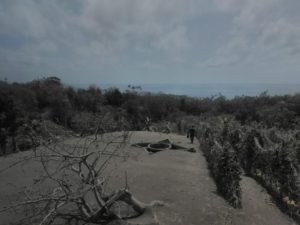
Photo (unedited) – An apocalyptic scene in the red zone (Orange Hill) after the volcanic eruption.
The expansion of the local beekeeping industry within the last 5 years had led to new apiary establishments being extended to the northern communities on mainland St. Vincent. These areas were located in the red and orange zones of the volcanic map. These were the hives that suffered the most during the eruption.
A week after the first explosive eruption on April 15th, a preliminary damage assessment was conducted by Mr. Allan Williams – Apiculture Extensionist of the Ministry of Agriculture who was accompanied by Mr. Marcus Richards Senior Agricultural Officer also of the Ministry of Agriculture. The assessment within itself was a risk and could have only been done on the North Windward side of the island which is located in the red zone. At first glance, the apocalyptic results of ash-fall even before reaching apiary sites were overwhelming. There was as much as 6 – 8 inches of ashfall observed in the red zones.
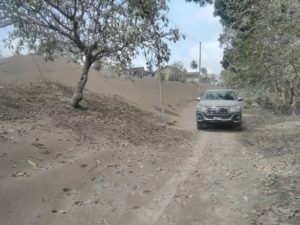
Photo (unedited) – Access road to an apiary site in the red zone (Orange hill) that was a very rough path before the ash-fall.
Torrential rain that was induced by the volcanic eruption condensed the ashfall on the ground, to 4 – 5 inches. The condensed ashfall in those areas especial on feeder roads resembled as if they were just finished paved with grey asphalt.
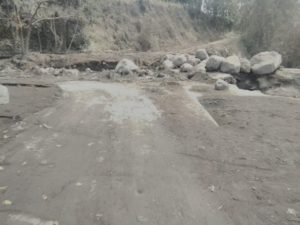
Photo – Main road severed by lahars where there was once a small bridge in the red zone.
Torrential rain also caused massive and multiple lahars that destroyed roads and bridges in its path. Therefore some apiaries could have been only accessed on foot. From the, preliminary assessment and direct reports a total of 45 hives were damaged which accounted for 42% of the hives that remained in the danger zones. There were two newly erected apiary sheds that had also collapsed on domesticated hives under them due to the weight of the ash-mud on the roof. The hives under these sheds suffered double calamity; not only have they been toppled by the collapsed shed but both the shed and ash smothered the hives. As a result there was little or no hope for their survival. Other domesticated hives in the open field were covered with thick ash.

Photos above – hives in the red zone (in Trinity – the closest apiary from the volcano) that were severely affect as well the shed.
There were still greater challenges after the eruption. The whole red zone became a desert of ash. Therefore, there were no sources of pollen and nectar for the honey bees. In addition, most natural water sources were contaminated with the minerals from the volcanic ash. These challenges were also extended to those apiaries that were found in the orange, yellow zones and some parts of the green zone (to a lesser extent). This was a serious threat to the health and sustenance of the surviving hives. A total of 350 domesticated hives were under this immediate threat.
At the end of March there were 702 domesticated colonies recorded throughout St. Vincent and the Grenadines but by the end of April after the La Soufriere volcanic eruptions domesticated colonies were reduced to 595 among 93 beekeepers. Within one month there was a 15% decline in the total number of hives in SVG.
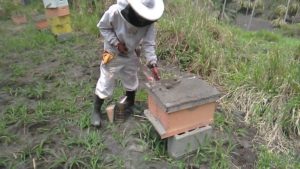
Photo – removing ash from the top and the entrance of a hive that remained in the red zone but survived the La Soufriere volcanic eruption.
Honeybees themselves are very resilient by nature. Many lessons of life can be learned from them. For example, the strong bee hives capitalized on the falling ash-mud and sealed up their entrances until the surroundings were clear again. Also, on reflecting the day or two before the volcano bee hives were vigorously collecting pollen stores, more than normal.
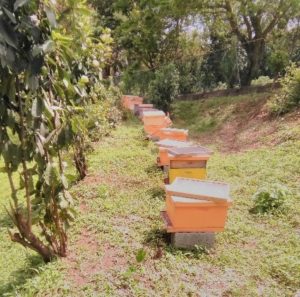
Photo – one month after hives that were relocated from the red zone to the green zone. The mesh-top covers were just replaced with solid-top covers.
Some hives were able to be relocated after the red alert was given -18 hours prior to the first actual volcanic eruption. These hives were moved to the green zone where most of the domesticated hives in SVG are located. 80% of the domesticated hives in SVG are located in the green zone of the volcano.
As a result there is a response needed for the domesticated and feral colonies that somehow survived the volcanic eruption in main affected zones. Under the rubble, debris and ash few hives had miraculously survived. As soon as some beekeepers were able to pass emergency check points to enter into the danger zones they tried their best to salvage whatever they could reuse and bees that might be able to survive the drought of nectar and pollen sources in the upcoming months. The surviving hives were in need of clean drinking water, and in the interim they were also in need of nectar and pollen substitutes. All of which in some cases have to be transported manually to the apiaries in order to reduce further loss of hives. These are the challenges that the beekeepers will have to endure until the natural vegetation is rehabilitated or when vehicular access is regained to relocate apiaries further south of the mainland.
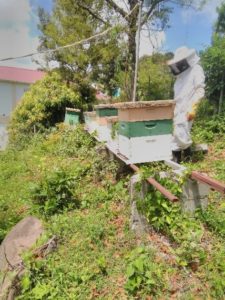
Photo – An apiary in the green zone one month after the La Soufriere the volcanic eruption.
Queen Rearing and hive breeding is another response that has to be done locally for building resilience of the thriving beekeeping industry in SVG, so that beekeepers will be able to replenish hives efficiently. A local apiary has to be primarily designated for this activity in order to support beekeepers in regaining their livelihood and continue to build the beekeeping industry in St. Vincent and the Grenadines. The experience of the volcanic eruption in 2021 has left long lasting memories among the beekeepers.
Amidst these challenges, the SVG Beekeepers Association (SVGBA) in association with the Association for Caribbean Beekeepers Organization (ACBO) are still proceeding with plans to host the International Caribbean Beekeeping Congress in September 2022 under the theme: “Building the Resilience of a Beekeeping Industry after a Volcanic Eruption.”


